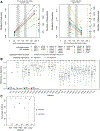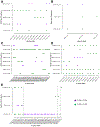Position-Dependent Differential Targeting of Somatic Hypermutation
- PMID: 33188076
- PMCID: PMC7726104
- DOI: 10.4049/jimmunol.2000496
Position-Dependent Differential Targeting of Somatic Hypermutation
Abstract
Somatic hypermutation (SHM) generates much of the Ab diversity necessary for affinity maturation and effective humoral immunity. The activation-induced cytidine deaminase-induced DNA lesions and error-prone repair that underlie SHM are known to exhibit intrinsic biases when targeting the Ig sequences. Computational models for SHM targeting often model the targeting probability of a nucleotide in a motif-based fashion, assuming that the same DNA motif is equally likely to be targeted regardless of its position along the Ig sequence. The validity of this assumption, however, has not been rigorously studied in vivo. In this study, by analyzing a large collection of 956,157 human Ig sequences while controlling for the confounding influence of selection, we show that the likelihood of a DNA 5-mer motif being targeted by SHM is not the same at different positions in the same Ig sequence. We found position-dependent differential SHM targeting for about three quarters of the 38 and 269 unique motifs from more than half of the 292 and 1912 motif-allele pairs analyzed using productive and nonproductive Ig sequences, respectively. The direction of the differential SHM targeting was largely conserved across individuals with no allele-specific effect within an IgH variable gene family, but was not consistent with general decay of SHM targeting with increasing distance from the transcription start site. However, SHM targeting did correlate positively with the mutability of the wider sequence neighborhood surrounding the motif. These findings provide insights and future directions for computational efforts toward modeling SHM.
Copyright © 2020 by The American Association of Immunologists, Inc.
Conflict of interest statement
Conflict of Interest Statement
S.H.K. receives consulting fees from Northrop Grumman.
Figures





Similar articles
-
Interpretable deep learning reveals the role of an E-box motif in suppressing somatic hypermutation of AGCT motifs within human immunoglobulin variable regions.Front Immunol. 2024 May 28;15:1407470. doi: 10.3389/fimmu.2024.1407470. eCollection 2024. Front Immunol. 2024. PMID: 38863710 Free PMC article.
-
A Model of Somatic Hypermutation Targeting in Mice Based on High-Throughput Ig Sequencing Data.J Immunol. 2016 Nov 1;197(9):3566-3574. doi: 10.4049/jimmunol.1502263. Epub 2016 Oct 5. J Immunol. 2016. PMID: 27707999 Free PMC article.
-
Recombinase-mediated cassette exchange as a novel method to study somatic hypermutation in Ramos cells.mBio. 2011 Oct 11;2(5):e00186-11. doi: 10.1128/mBio.00186-11. Print 2011. mBio. 2011. PMID: 21990614 Free PMC article.
-
Beyond Hot Spots: Biases in Antibody Somatic Hypermutation and Implications for Vaccine Design.Front Immunol. 2018 Aug 14;9:1876. doi: 10.3389/fimmu.2018.01876. eCollection 2018. Front Immunol. 2018. PMID: 30154794 Free PMC article. Review.
-
A/T-targeted somatic hypermutation: critique of the mainstream model.Trends Biochem Sci. 2006 May;31(5):252-8. doi: 10.1016/j.tibs.2006.03.008. Epub 2006 Apr 17. Trends Biochem Sci. 2006. PMID: 16616496 Review.
Cited by
-
Adaptive Immune Receptor Repertoire (AIRR) Community Guide to Repertoire Analysis.Methods Mol Biol. 2022;2453:297-316. doi: 10.1007/978-1-0716-2115-8_17. Methods Mol Biol. 2022. PMID: 35622333 Free PMC article.
-
Somatic Diversification of Rearranged Antibody Gene Segments by Intra- and Interchromosomal Templated Mutagenesis.J Immunol. 2022 May 1;208(9):2141-2153. doi: 10.4049/jimmunol.2100434. Epub 2022 Apr 13. J Immunol. 2022. PMID: 35418472 Free PMC article.
-
Protein language model pseudolikelihoods capture features of in vivo B cell selection and evolution.Brief Bioinform. 2025 Jul 2;26(4):bbaf418. doi: 10.1093/bib/bbaf418. Brief Bioinform. 2025. PMID: 40825239 Free PMC article.
-
Interpretable deep learning reveals the role of an E-box motif in suppressing somatic hypermutation of AGCT motifs within human immunoglobulin variable regions.Front Immunol. 2024 May 28;15:1407470. doi: 10.3389/fimmu.2024.1407470. eCollection 2024. Front Immunol. 2024. PMID: 38863710 Free PMC article.
-
Deep learning model of somatic hypermutation reveals importance of sequence context beyond hotspot targeting.iScience. 2021 Dec 20;25(1):103668. doi: 10.1016/j.isci.2021.103668. eCollection 2022 Jan 21. iScience. 2021. PMID: 35036866 Free PMC article.
References
-
- Methot SP, and Di Noia JM. 2017. Molecular Mechanisms of Somatic Hypermutation and Class Switch Recombination. Adv. Immunol 133: 37–87. - PubMed
Publication types
MeSH terms
Substances
Grants and funding
LinkOut - more resources
Full Text Sources
Miscellaneous

